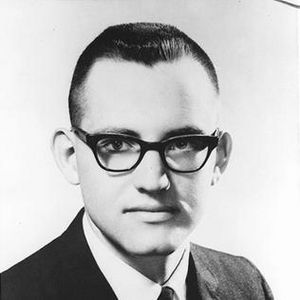Bruce W. Klunder facts for kids
Quick facts for kids
Reverend
Bruce W. Klunder
|
|
|---|---|

Klunder in an undated photo
|
|
| Born | July 12, 1937 Greeley, Colorado, U.S.
|
| Died | April 7, 1964 (aged 26) |
| Cause of death | Crushed to death |
| Resting place | Church of the Covenant, Cleveland, Ohio |
| Education |
|
| Occupation | Minister, activist |
| Years active | 1955–64 |
| Organization | Congress of Racial Equality |
| Movement | Civil Rights Movement |
| Spouse(s) | Joanne Lehman |
| Children | 2 |
Reverend Bruce W. Klunder (born July 12, 1937 – died April 7, 1964) was a brave Presbyterian minister and a leader in the Civil Rights Movement. He was born in Colorado, USA. He sadly died while protesting against a school that would have kept students separated by race, known as a segregated school, in Cleveland, Ohio.
Bruce Klunder studied science at Oregon State University, graduating in 1958. There, he met his future wife, Joanne Lehman. They married in 1956. He then earned a special degree in religion from Yale Divinity School in 1961.
After college, Bruce and Joanne moved to Cleveland. He quickly joined the fight for civil rights in the city. He was very passionate about equal rights for all people. He led the local group of the Congress of Racial Equality (CORE). In 1962, he led a protest where people sat in a restaurant in Sewanee, Tennessee, to challenge segregation. At this time, he and his wife had two young children.
Contents
Fighting for Equal Rights
Bruce Klunder often joined protests. He spoke out for fair housing, meaning everyone should have the right to live where they choose. He also protested against public places that were separated by race. He fought against unfair hiring practices too.
When the Cleveland City School District planned to build new schools, Klunder saw a problem. These schools would have continued the pattern of separating students by race. He decided to lead efforts to stop their construction.
The School Protests Begin
One afternoon, about 100 people protested at the school construction site. They stood in front of bulldozers and other machines. They wanted to stop the building work. Six people, including a pregnant woman, even lay down in a ditch. Police tried to make the protesters leave. Many refused and continued to protest. Twenty-one people were arrested that day. Two people were also hurt.
Klunder's Tragic Death
The very next day, Bruce Klunder returned to the school site. About 1,000 other protesters joined him. Many Cleveland police officers were already there. Moments later, Klunder, two women, and another man ran towards a bulldozer. Three of them lay down in front of the machine. Klunder lay down behind it.
The bulldozer driver, John White, stopped when he saw the three people in front. He looked around but did not see Klunder. He then backed up the machine. When the driver finally stopped, Klunder was dead.
Aftermath and Legacy
Bruce Klunder's death caused a lot of anger in Cleveland. Protests grew, and some turned into fights. Police had to use tear gas to control the crowds. More than 3,500 people were protesting. A local newspaper reported that police used tear gas to scatter the crowds. Thirteen people, including eight police officers, were injured. Twenty-six people were arrested.
The day after, protesters held a quiet memorial. They gathered in front of the Board of Education Building. Klunder's funeral was held at the Church of the Covenant. A leader from the United Presbyterian Church, Eugene Carson Blake, spoke at the service. About 1,500 people attended.
Klunder's death divided the Cleveland community. Some people thought his death was a result of things getting out of control. Others saw his actions as a brave act of love for his community.
Bruce Klunder is remembered as one of the 41 people listed as civil rights martyrs. His name is on the national Civil Rights Memorial in Montgomery, Alabama.
In 2013, the Stephen E. Howe Elementary School was torn down. This was the school whose construction led to the protests. Long-time Cleveland residents were interviewed about its history. Reverend E. Theophilus Caviness, who was there in 1964, said something important. He told The Plain Dealer that the school ground is "sacred ground." He said it is a "sacred location to all of us who were here." It reminds them of what the struggle was all about.
See also

